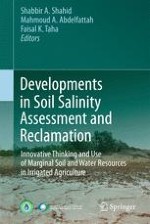2013 | OriginalPaper | Buchkapitel
24. The Reclamation Effects Should Be Considered for Saline Soil Criteria in Soil Classification System
verfasst von : Zhang Fengrong, Zheng Zhong
Erschienen in: Developments in Soil Salinity Assessment and Reclamation
Verlag: Springer Netherlands
Aktivieren Sie unsere intelligente Suche, um passende Fachinhalte oder Patente zu finden.
Wählen Sie Textabschnitte aus um mit Künstlicher Intelligenz passenden Patente zu finden. powered by
Markieren Sie Textabschnitte, um KI-gestützt weitere passende Inhalte zu finden. powered by
